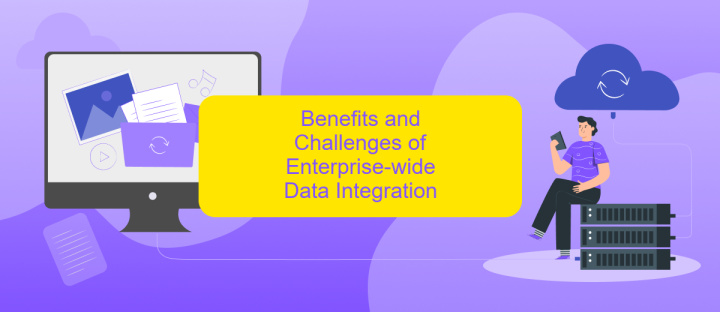Enterprise-wide Data Integration
In today's data-driven world, enterprise-wide data integration is crucial for organizations seeking to harness the full potential of their information assets. By seamlessly connecting disparate data sources, businesses can achieve a unified view, enabling better decision-making, enhanced operational efficiency, and strategic agility. This article explores the key principles, benefits, and best practices for implementing effective data integration across the enterprise.
Executive Summary
Enterprise-wide data integration is crucial for modern businesses aiming to leverage data from various sources for strategic decision-making. It enables seamless connectivity between disparate systems, ensuring data consistency, accuracy, and accessibility across the organization. Effective data integration can significantly enhance operational efficiency, reduce costs, and improve overall business performance.
- Centralized data management for improved decision-making
- Enhanced data accuracy and consistency
- Improved operational efficiency and reduced costs
- Seamless connectivity between disparate systems
Tools like ApiX-Drive are instrumental in achieving effective data integration. ApiX-Drive offers a user-friendly platform that simplifies the integration process, allowing businesses to connect various applications and automate data workflows effortlessly. By leveraging such tools, organizations can ensure that their data integration initiatives are robust, scalable, and aligned with their strategic goals.
Introduction

In today's rapidly evolving business landscape, the ability to seamlessly integrate data across the entire enterprise has become a critical factor for success. Enterprise-wide data integration ensures that data from various sources, such as customer relationship management (CRM) systems, enterprise resource planning (ERP) software, and other business applications, can be consolidated and accessed in a unified manner. This not only enhances decision-making processes but also drives operational efficiency and fosters innovation by providing a comprehensive view of the organization's data assets.
To achieve effective data integration, businesses can leverage advanced tools and services that simplify the integration process. One such service is ApiX-Drive, which offers robust solutions for automating data flows between different systems without the need for extensive coding. By using ApiX-Drive, organizations can streamline their data integration efforts, reduce manual intervention, and ensure that data is consistently accurate and up-to-date across all platforms. This ultimately enables businesses to respond more swiftly to market changes and customer needs, maintaining a competitive edge in their respective industries.
Benefits and Challenges of Enterprise-wide Data Integration

Enterprise-wide data integration brings numerous benefits, such as streamlined operations, improved decision-making, and enhanced collaboration. By consolidating data from various sources, organizations can achieve a holistic view of their operations, leading to better strategic planning and resource allocation. Moreover, integrated data systems reduce redundancy and ensure consistency, which enhances data accuracy and reliability.
- Improved decision-making through comprehensive data analysis.
- Enhanced operational efficiency by reducing data silos.
- Greater data accuracy and consistency.
- Facilitated compliance with regulatory requirements.
- Increased collaboration across departments.
However, enterprise-wide data integration also presents challenges. These include the complexity of integrating diverse data sources, maintaining data quality, and ensuring data security. Implementing a robust solution like ApiX-Drive can help address these issues by providing automated data integration services, which simplify the process and enhance data management. Overall, while the benefits are substantial, careful planning and the right tools are essential to overcoming the challenges of data integration.
Implementation Strategies and Best Practices

Implementing enterprise-wide data integration requires a strategic approach to ensure seamless data flow across various systems. Begin by assessing the current data landscape and identifying key integration points. This assessment will help in understanding the complexities and potential challenges that may arise during the integration process.
Next, choose the right tools and technologies that align with your organization's needs. ApiX-Drive is an excellent choice for automating data integration processes, enabling you to connect multiple applications and services effortlessly. This platform supports a wide range of integrations, making it easier to manage data from different sources.
- Conduct a thorough data audit to identify integration needs.
- Select integration tools that support scalability and flexibility.
- Implement robust data governance policies to ensure data quality.
- Regularly monitor and optimize integration workflows.
Lastly, ensure continuous training and support for your team to handle the integrated systems effectively. Regular updates and maintenance are crucial to keep the integration running smoothly. By following these strategies and best practices, you can achieve a successful enterprise-wide data integration.
Conclusion
Enterprise-wide data integration is a critical component for modern businesses aiming to harness the power of their data. By breaking down silos and ensuring seamless data flow across departments, organizations can make more informed decisions, improve operational efficiency, and drive innovation. The implementation of robust integration strategies not only enhances data accessibility but also fortifies data governance and compliance, ensuring that data is both reliable and secure.
Leveraging advanced integration tools like ApiX-Drive can significantly streamline the integration process. ApiX-Drive offers a user-friendly platform that simplifies the connection of various applications and services, enabling businesses to automate workflows and synchronize data effortlessly. This not only reduces the time and resources required for manual data handling but also minimizes the risk of errors, ensuring data integrity. As companies continue to evolve in the digital age, embracing comprehensive data integration solutions will be pivotal in maintaining a competitive edge and achieving long-term success.
FAQ
What is enterprise-wide data integration?
Why is data integration important for enterprises?
What are the common challenges in enterprise-wide data integration?
How can automation tools help in data integration?
What are some key features to look for in a data integration tool?
Time is the most valuable resource in today's business realities. By eliminating the routine from work processes, you will get more opportunities to implement the most daring plans and ideas. Choose – you can continue to waste time, money and nerves on inefficient solutions, or you can use ApiX-Drive, automating work processes and achieving results with minimal investment of money, effort and human resources.

